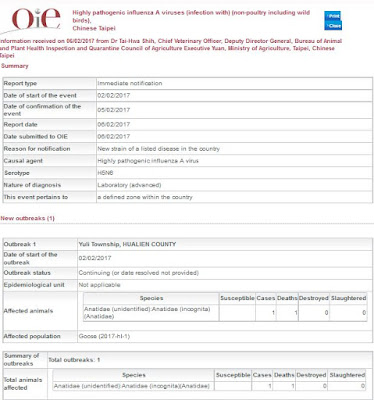#12,205
The `big' story for today (bearing in mind it is still early) has been the first detection of HPAI H5N6 on the island of Taiwan (see Taiwan BAPHIQ: HPAI H5N6 Found In Dead Goose) and their immediate response (see Taiwan: CDC Statement On 1st Detection Of H5N6).
Given its recent jumps - first to South Korea and then to Japan - the arrival of H5N6 to Taiwan has been more or less expected for the past couple of months.Expected or not, this has the potential to greatly impact Taiwan's poultry industry, which has only recently recovered from their 2015 epizootic with H5N8.
While it's only been a few hours, the OIE has already posted the following notification.
Epidemiological comments
The animal health authority, BAPHIQ, entrusts the Wild Bird Society of Taipei (a non-governmental organization) to conduct active surveillance of wild bird for avian influenza. One dead young goose was found on a country road in Hualien County by the Wild Bird Society of Taipei and was sent to the National Laboratory (Animal Health Research Institute, AHRI) on 2 February 2017. H5N6 subtype HPAI was detected and confirmed by the AHRI in the evening of 5 February 2017.
The HA and NA genomic sequences of the virus seem to share high similarity (99%) with those of the virus which has caused major outbreaks in Korea and Japan according to preliminary analysis by the AHRI. The Local Disease Control Center (LDCC) disinfected the neighboring areas of the spot where the dead goose was found and has completed clinical examination and sampling of all poultry farms (2 duck farms) within 1 km radius of the spot. All ducks in the 2 farms are clinically healthy.
Surrounding poultry farms within 3 km radius of the index spot will also be sampled as soon as possible and they are under intensified surveillance for 3 months to detect, if any, spreading of the virus. Until 21 February 2017, all waterfowls of Hualien County must be slaughtered locally, no dispatch to other regions of the country is allowed.

